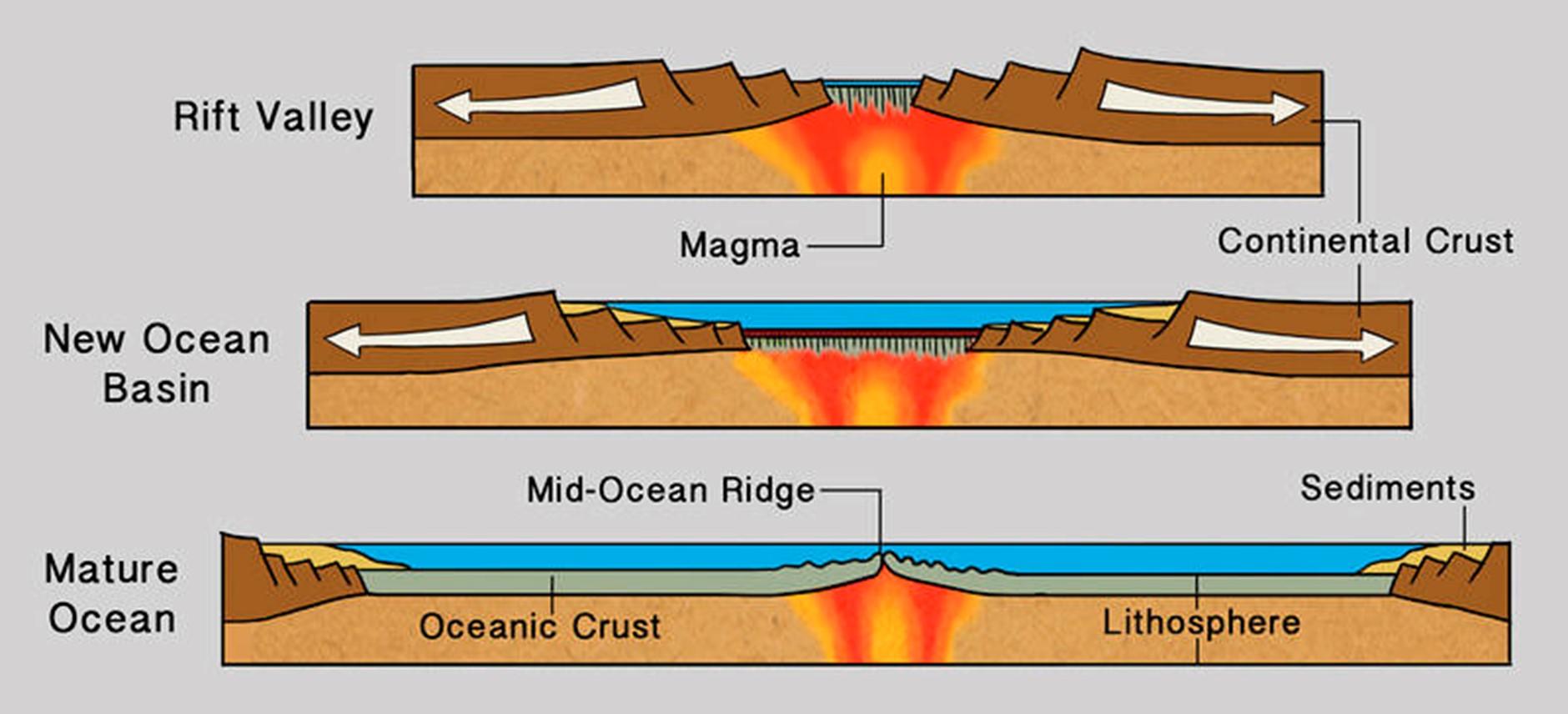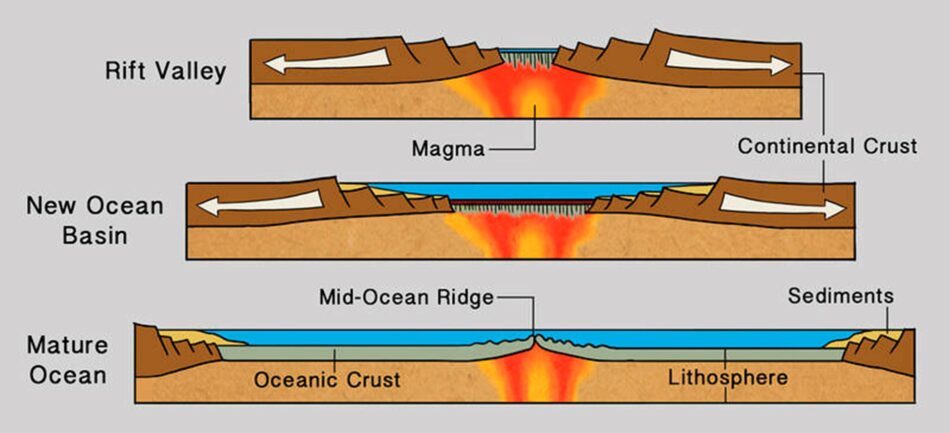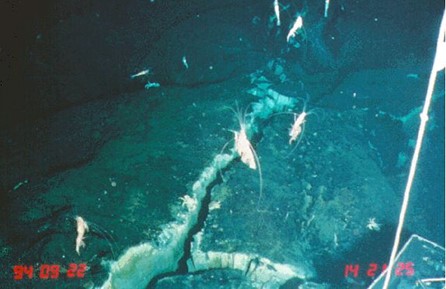The Global Marine Group is pleased to announce the new ownership of the business by Keppel Infrastructure Fund, a fund managed by Keppel.
Contact Us

Divergent plate boundaries are locations where tectonic plates are moving away from each other and create new oceanic lithosphere through shield or fissure volcanoes. The Wilson Cycle details that divergent boundaries present on land, in the form of rift valleys, are early phase divergent boundaries. They are subject to lithospheric (outer crust) rifting and form graben structures through normal faulting. Through several processes the lithosphere becomes more basaltic and the magma rises (East African Rift). The aesthenosphere (upper mantle) rises below these rifts and aids the continental plate in diverging, creating dense oceanic lithosphere in the spaces left by faulting in the graben (Red Sea). Over time the oceanic lithosphere matures and separates the continental landmasses through seafloor spreading at mid-oceanic ridges (Mid-Atlantic Ridge).
Both slow and fast-spreading boundaries present challenges when engineering a cable route. Not only are eruptions difficult to predict when and where they occur for both types of ridge, but if a new fissure is created at a slow spreading ridge, the cable could become suspended, suffer abrasion damage from movement of rocks or sediment, not to mention the associated seismic damage that could occur.

Mid-ocean ridges form a topographic high, visible on bathymetric data, which form an underwater mountain system that is typically ~2000m above the abyssal plain. The mid-ocean ridge system is almost 65,00km and stretches from the top of Greenland to Antarctica, from the Pacific Ocean, past South America, Africa, Australia and New Zealand, into the Pacific again. Over 90 percent of the system is underwater. Although some sections are terrestrial, such as the Mid-Atlantic Ridge (MAR) at Iceland.

Mid-ocean ridges can vary in appearance depending on the spreading rate experienced. At slow spreading boundaries (Mid-Atlantic Ridge) the ridge has steep, irregular topography, much like rift valleys. Whereas at fast spreading boundaries the ridge, although a wider profile, has smooth gentle slopes with only a small crack present in the lava flows at the summit.

Both ridge morphologies present challenges when engineering a cable route. Not only are eruptions difficult to predict when and where they occur for both types of ridge, but if a new fissure is created at a slow spreading ridge, the cable could become suspended, suffer abrasion damage from movement of rocks or sediment, not to mention the associated seismic damage that could occur. The fissures at fast spreading ridges are less likely to cause significant suspension or abrasion. However, an additional 17cm a year translates to an additional 4.25m over the lifecycle of a cable. Therefore, additional slack may be required in such areas. Although volcanoes and earthquakes occur at divergent boundaries, they are generally less violent than at other boundary types. This is due to the chemical composition of the magma, along with less volatiles being present that cause a reaction. In addition, less energy is required for the process of divergence than convergence.
References:
BGS, 2022. What causes earthquakes? British Geological Survey. Available at: https://www.bgs.ac.uk/discovering-geology/earth-hazards/earthquakes/what-causes-earthquakes/
GeolSoc, 2022. Plate Tectonics. The Geological Society. Available at: https://www.geolsoc.org.uk/Plate-Tectonics
Global Volcanism Program (GVP), 2022. Image Gallery for Submarine Volcanoes. Distributed by Smithsonian Institute. Available at: https://volcano.si.edu/gallery/ImageCollection.cfm?gallery=VolTypeSubmarine
Johnson, C., et al., 2017. An Introduction to Geology. Chapter 2 Plate Tectonics. Salt Lake Community College. Available at: https://opengeology.org/textbook/
King, H., 2005. Plate Tectonics. Geology.com. Available at: https://geology.com/plate-tectonics/
NOAA, 2022. What are the different types of plate tectonic boundaries? National Oceanic and Atmospheric Administration: Ocean Exploration. Available at: https://oceanexplorer.noaa.gov/facts/plate-boundaries.html
NOAA, 2022[1]. What is the mid-ocean ridge? National Oceanic and Atmospheric Administration: Ocean Exploration. Available at: https://oceanexplorer.noaa.gov/facts/mid-ocean-ridge.html
UNM, 2018. Scientists detect deep carbon emissions associated with continental rifting. University of New Mexico. Available at: https://www.geologyin.com/2016/01/scientists-detect-deep-carbon-emissions.html
USGS, 2014. Understanding plate motions. US Geological Society. Available at: https://pubs.usgs.gov/gip/dynamic/understanding.html
van Andel, T. H., 2022. Plate tectonics. Encyclopaedia Britannica. Available at: https://www.britannica.com/science/plate-tectonics

Neil is one of OceanIQ’s experienced Route Engineers

| Cookie | Duration | Description |
|---|---|---|
| bcookie | 2 years | LinkedIn sets this cookie from LinkedIn share buttons and ad tags to recognize browser ID. |
| lang | session | This cookie is used to store the language preferences of a user to serve up content in that stored language the next time user visit the website. |
| lidc | 1 day | LinkedIn sets the lidc cookie to facilitate data center selection. |
| __atuvc | 1 year 1 month | AddThis sets this cookie to ensure that the updated count is seen when one shares a page and returns to it, before the share count cache is updated. |
| __atuvs | 30 minutes | AddThis sets this cookie to ensure that the updated count is seen when one shares a page and returns to it, before the share count cache is updated. |
| __cf_bm | 30 minutes | This cookie, set by Cloudflare, is used to support Cloudflare Bot Management. |
| __hssc | 30 minutes | HubSpot sets this cookie to keep track of sessions and to determine if HubSpot should increment the session number and timestamps in the __hstc cookie. |
| Cookie | Duration | Description |
|---|---|---|
| hubspotutk | 1 year 24 days | This cookie is used by HubSpot to keep track of the visitors to the website. This cookie is passed to Hubspot on form submission and used when deduplicating contacts. |
| uvc | 1 year 1 month | Set by addthis.com to determine the usage of addthis.com service. |
| vuid | 2 years | Vimeo installs this cookie to collect tracking information by setting a unique ID to embed videos to the website. |
| _ga | 2 years | The _ga cookie, installed by Google Analytics, calculates visitor, session and campaign data and also keeps track of site usage for the site's analytics report. The cookie stores information anonymously and assigns a randomly generated number to recognize unique visitors. |
| _gat_UA-178530081-1 | 1 minute | A variation of the _gat cookie set by Google Analytics and Google Tag Manager to allow website owners to track visitor behaviour and measure site performance. The pattern element in the name contains the unique identity number of the account or website it relates to. |
| _gid | 1 day | Installed by Google Analytics, _gid cookie stores information on how visitors use a website, while also creating an analytics report of the website's performance. Some of the data that are collected include the number of visitors, their source, and the pages they visit anonymously. |
| __hstc | 1 year 24 days | This is the main cookie set by Hubspot, for tracking visitors. It contains the domain, initial timestamp (first visit), last timestamp (last visit), current timestamp (this visit), and session number (increments for each subsequent session). |
| Cookie | Duration | Description |
|---|---|---|
| bscookie | 2 years | This cookie is a browser ID cookie set by Linked share Buttons and ad tags. |
| loc | 1 year 1 month | AddThis sets this geolocation cookie to help understand the location of users who share the information. |
| Cookie | Duration | Description |
|---|---|---|
| AnalyticsSyncHistory | 1 month | No description |
| at-rand | never | No description available. |
| ep201 | 30 minutes | This cookie is set by the provider Surveymonkey. This cookie is used for statistical analysis and website optmization. It gathers information on user's interaction with the SurveyMonkey- Widget on thewebsite. |
| ep203 | 3 months | No description available. |
| li_gc | 2 years | No description |
| m | 2 years | No description available. |
| paywallredirect | 1 day | No description |
| UserMatchHistory | 1 month | Linkedin - Used to track visitors on multiple websites, in order to present relevant advertisement based on the visitor's preferences. |